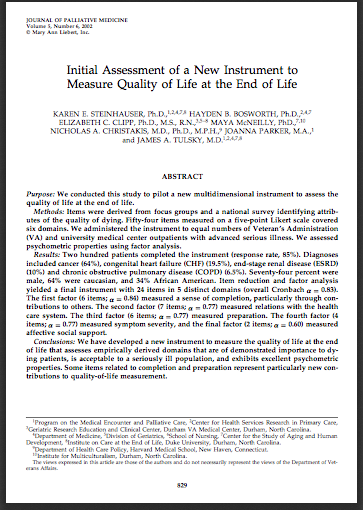
Initial Assessment of a New Instrument to Measure Quality of Life at the End of Life
Abstract
Purpose: We conducted this study to pilot a new multidimensional instrument to assess the quality of life at the end of life.
Methods: Items were derived from focus groups and a national survey identifying attributes of the quality of dying. Fifty-four items measured on a five-point Likert scale covered six domains. We administered the instrument to equal numbers of Veteran's Administration (VA) and university medical center outpatients with advanced serious illness. We assessed psychometric properties using factor analysis.
Results: Two hundred patients completed the instrument (response rate, 85%). Diagnoses included cancer (64%), congenital heart failure (CHF) (19.5%), end-stage renal disease (ESRD) (10%) and chronic obstructive pulmonary disease (COPD) (6.5%). Seventy-four percent were male, 64% were caucasian, and 34% African American. Item reduction and factor analysis yielded a final instrument with 24 items in 5 distinct domains (overall Cronbach α = 0.83). The first factor (6 items; α = 0.84) measured a sense of completion, particularly through contributions to others. The second factor (7 items; α = 0.77) measured relations with the health care system. The third factor (6 items; α = 0.77) measured preparation. The fourth factor (4 items; α = 0.77) measured symptom severity, and the final factor (2 items; α = 0.60) measured affective social support.
Conclusions: We have developed a new instrument to measure the quality of life at the end of life that assesses empirically derived domains that are of demonstrated importance to dying patients, is acceptable to a seriously ill population, and exhibits excellent psychometric properties. Some items related to completion and preparation represent particularly new contributions to quality-of-life measurement.
Citation:
K.E. Steinhauser, H.B. Bosworth, E.C. Clipp, M. McNeilly, N.A. Christakis, J. Parker, and J.A. Tulsky, "Initial Assessment of a New Instrument to Measure Quality of Life at the End of Life" Journal of Palliative Medicine, 5(6): 829-841 (December 2002)